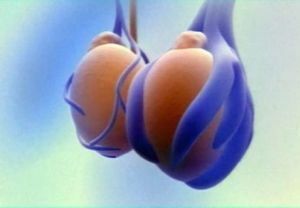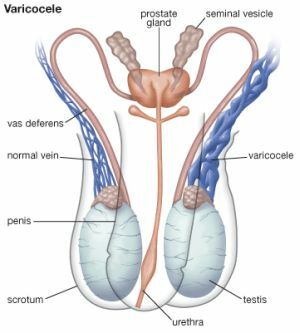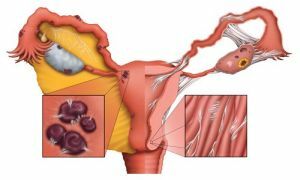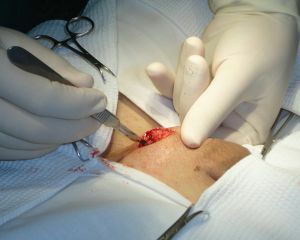 The name of the disease comes from the Latin "varicis" - expansion, bloating on the veins, "kele" - a tumor. This is a male disease, which is characterized by dilated veins of the testicles and the seed cuff .
The name of the disease comes from the Latin "varicis" - expansion, bloating on the veins, "kele" - a tumor. This is a male disease, which is characterized by dilated veins of the testicles and the seed cuff .
Often the disease is accompanied by additional signs - enlarged veins on the legs, hemorrhoids. Usually, the varicocele is formed on the left( extremely rarely - on the right or on both sides), since the left spermatic vein at right angles empties into the renal.
The disease does not belong to the list of "deadly" or "excruciating": a man can lead a normal life without suspecting anything until this problem begins to disturb him in the last stages( concomitant signs).
The most common disease is diagnosed from 12 to 25 years.
Contents
- Anatomy and physiology
- How does varicocele occur?
- Who is most predisposed to the disease
- Causes of the disease
- Classification of the pathology
- General approach to the treatment of the disease
- Prevention of the disease
- Video: Symptoms of varicocele
Anatomy and physiology
The internal testicle is one of the ways of outflow of blood from the testicle. On the right the vessel empties into the inferior vena cava, on the left - into the renal vein. In renal blood pressure is much higher than in the testicle.
If a man does not suffer varicocele, the vein valves in the testicle prevent the discharge of blood from the renal vein vessel into the testicle. Thus, the blood is evenly distributed on both testicles.
How does varicocele occur?
If a disease occurs, disrupts the nutrition of one of the testicles , which results in atrophy( gradual death of the testicle).
As already mentioned, the venous valves perform a regulatory function, controlling the pressure in the testicle and distributing the blood evenly. 
However, if these valves function incorrectly or completely absent, the pressure in the testicle increases and blood flow will be directed from the left renal vein to the left testicle vein. Compensatory stagnation phenomena will occur in the veins of the seminal cantus.
Thus, in the testicle, blood circulation is disrupted, temperature in it rises ( due to a large accumulation of blood) - oppression of the testicle occurs( sperm is produced only at a temperature of 32.5 - 34.4 degrees), and then - organ dying.
Who is most susceptible to
? There is a specific at risk:
- Adolescents aged 13-15 years( because during this period the body is actively growing, is also affected by an excessively high level of testosterone).However, often the ailment is diagnosed only after puberty, due to the irregularity of the examinations and the absence of symptoms in the early stages.
- Athletes.
- Manual workers.
- People with congenital preconditions for the disease( heredity).
- Men who underwent an operation to remove dropsy.
Sometimes, several factors can immediately trigger the onset of the disease.
 This is important! Why does thrombus come off and what consequences can it lead to without timely assistance considered in our article.
This is important! Why does thrombus come off and what consequences can it lead to without timely assistance considered in our article.
Very often after female operations complications occur in the form of limphostasis of the extremities. How to treat lymphostasis of the hand and in time to make a diagnosis you need to know everyone.
Causes of
disease The main causes of varicocele are:
- Genetic ( the body's tendency to varicose veins).Those who have relatives with flat feet, heart disease, BPV are at risk. Any anomaly in the development of the venous structure can cause varicocele( weakness of the walls, defects of the venous valves. ..).
- Feature of the structure of the body ( the left renal vein is impaired among the large vessels of the aorta).
- Reduced lumen in the veins ( therefore, the blood pressure rises, the walls are stretched, the testicle veins are pinched).
- Neoplasms in the abdominal cavity of , abdominal, in the pelvic organs( both benign and malignant).This substance can press on the veins of the plexus plexus, increasing blood pressure.
- Constant problems with chair( constipation, diarrhea).Because of constant strain on constipation, the blood very often pours to the organs of the small pelvis, creating an increased pressure. With diarrhea, the pressure rises due to frequent defecation.
- Constant weight lifting ( there is a rush of blood to the lower parts of the body, the pressure in the veins increases, and sharply).
- Overweight : this factor is two-sided. In the first case, the vessels of the small pelvis are infringed by an excessive fatty layer in the abdomen. In the second - due to the overall burden on the cardiovascular system.
- Irregular sexual life ( stagnation occurs in the pelvic organs, which indirectly provokes varicose veins in that area).The optimal for a man will perform sexual intercourse 2-3 times a week.
- Inflammation of the reproductive system ( chronic inflammation can lead to the formation of scar tissue that infringes the testicular veins).
Classification of pathology
 The main criterion for the distribution of varicocele for groups is as far as the seed vein and testicular veins are enlarged.
The main criterion for the distribution of varicocele for groups is as far as the seed vein and testicular veins are enlarged.
However, this is not the only classification.
The severity of symptoms of varicocele testis:
- subclinical stage: the veins are slightly enlarged, not detectable during examination, but can be diagnosed by ultrasound;
- is an easy stage: the veins expand periodically( with increased pressure in the abdominal region), it is diagnosed by the Valsalva test( the patient holds his breath and tenses);
- average: swollen veins are found on palpation( without delay of breathing);
- expressed: bloated veins on the scrotum are visible on examination.
* sometimes distinguishes three stages, excluding subclinical;there are many approaches to the classification of the disease according to this criterion.
Depending on disease location:
- left-sided;
- right-hand;
- double-sided.
Depending on the effect on the performance of sperm:
- normospermia( temperature in the testicle within normal limits);
- oligostenospermia( spermatozoa are formed in small amounts);
- necrospermia( not formed at all).
There is also a classification based on the symptoms of varicocele:
- asymptomatic varicocele;
- symptomatic:
- recurrent;
- sterile;
- complicated;
- with impaired spermatogenesis;
- painful;
- combined.
General approach to the treatment of
Disease It was previously thought that the diagnosis of varicocele is the first "bell" about the need for surgical intervention. But scientists have come to the conclusion that this is not entirely true.
Varicocele 1-2 stages ( proposed classification) does not require special treatment. 
It will be enough to eliminate the cause of blood congestion in the pelvic organs( for example, chronic constipation, diarrhea, excessive physical activity) and the pressure will return to normal.
At the third and fourth stage of the disease , when the symptoms of varicocele in men are pronounced, treatment is necessary. Varicocele can be treated operably or conservatively.
Conservative methods of treatment:
- venotonics( preparations that enhance the tone of the venous system);
- gymnastic exercises( to normalize the outflow of blood from the scrotum);
- injection of solution through the prick( which causes the fall of the veins);
- cryotherapy;
- intratone( therapy);
- intramag( effect of magnetic fields).
- intrastym( physiotherapy, which leads to a tonus of scrotum veins);
- vacuum faloerector therapy;
- massage( buttocks, thighs, abdomen, inguinal folds, perineum);
- wearing special underwear;
- vitamins, supplements, hormone therapy.
There are 120 types of surgical intervention in , intended for the treatment of varicocele.
The surgical intervention is considered much more effective than clinical methods.
Prevention of
- is a regular examination by a urologist( especially necessary after puberty is completed - at 19-20 years);
- avoid excessive physical exertion;
- in time to treat problems with stools;
- to have a regular sex life;
- not to abuse alcohol( since it dilates blood vessels);
- eat right, get all the necessary vitamins with food;
- exercise regularly( but competently), devote enough time to rest;
- if there is a genetic predisposition to the disease, then preventing the disease will be difficult, almost impossible;
- if you have a varicocele, do not apply warm compresses to reduce pain( only cold);
- in time diagnosed varicocele is an opportunity to eliminate it in the early stages and prevent surgical intervention.
Do not forget that this disease can deliver great physical discomfort, aesthetic, and even lead to infertility! Take care of your health well in advance.
Video: Symptoms of varicocele
The doctor talks about the main symptoms of varicocele. How to identify the disease yourself and what complications are fraught with pathology. About infertility, as a social side of the problem with varicocele.
